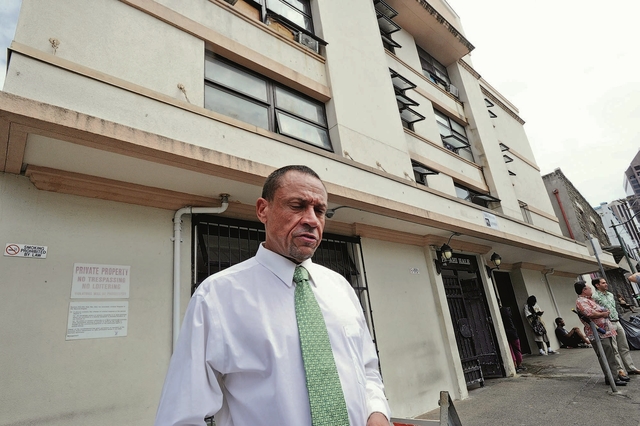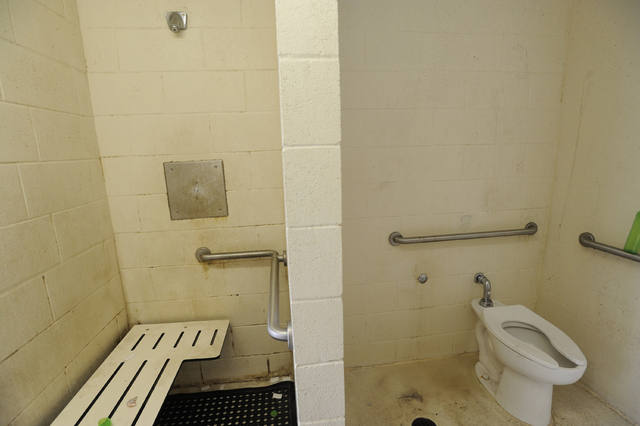As Kakaako homeless disperse, advocates seek new solutions

BRUCE ASATO / BASATO@STARADVERTISER.COM
Davis Lucas has made regular use of the hygiene center (toilet, shower and wash basin) at Pauahi Hale in Chinatown.

BRUCE ASATO / BASATO@STARADVERTISER.COM
At Pauahi Hale on Pauahi Street, the hygiene center has separate men’s and women’s rooms, each with one shower, toilet, pictured, and sink.


Federal housing and homeless officials toured the remains of the “Kakaako makai” homeless encampment this week and were pleased that it’s much smaller, but raised concerns about where everyone went.
Jennifer Leimaile Ho — the Washington, D.C.-based senior adviser on housing and services for the U.S. Department of Housing and Urban Development and niece of the late entertainer Don Ho — said it’s unknown how many of the people who were swept out of Kakaako makai ended up in stable, long-term housing.
“The test of all of this in the long run is, Is this resulting in people moving out of homelessness quicker and moving into housing?” Ho asked. “Is there a reduction in the number of people sleeping outside? Time will tell on that.”
During her last visit, in August, Katy Miller — Seattle-based regional coordinator for the U.S. Interagency Council on Homelessness — saw that 293 people were living in wood-reinforced tents and tarps around the University of Hawaii’s medical school and Hawaii Children’s Discovery Center.
This week a dozen or so tents lined the Kakaako shoreline, and Miller counted a handful more in Kakaako Makai Gateway Park, between the medical school and Children’s Discovery Center.
Miller called the encampment “very different than when I was there in August.”
Don't miss out on what's happening!
Stay in touch with breaking news, as it happens, conveniently in your email inbox. It's FREE!
While shelters took in some people, dozens more scattered throughout Kakaako and continue to be swept out of makeshift encampments.
Overall, Miller and Ho were pleased that county and state officials, nonprofit agencies and a host of others seem to be working together to reduce homelessness.
JOINING FORCES
Miller and Ho also participated in a two-day conference at Catholic Charities at which social workers met with health care providers and health insurers to brainstorm ways to leverage the Affordable Care Act, Medicaid and other systems and practices to simultaneously improve health care and reduce medical costs for the homeless, who often rely on 911, ambulances and costly emergency room care.
The federal officials were particularly pleased that about 100 people representing two groups that often do not work together on homelessness — social workers and health care officials — seemed “energized” to come up with a different, cheaper and more effective approach at the Catholic Charities gathering.
“We’re marrying two systems that haven’t always worked together,” Miller said. “There are many communities around the country trying to figure this out. When we look at the need in Hawaii, we know that the solution is to access all of the resources we can.”
HUD officials in Washington will take all of the ideas that were brainstormed at the conference and help develop “a prioritized action plan.”
“People really are stretching outside of the boundaries of how they’ve thought about this,” Ho said.
But around Honolulu, Ho and Miller heard pushback for the national “Housing First” model, which maintains that it’s more effective and cheaper to put homeless people in housing immediately, then provide help for issues that could include drug and alcohol abuse and mental health problems.
“People here are still warming to the idea that someone who has been living on the street for 10 years could actually move off the street and into housing,” Ho said. “We are seeing this work in communities all over the country. Until that is embraced and tested and proven here, people will continue to question it because Housing First is counterintuitive to what they’ve historically done. In this instance, what works on the mainland can be proven here. There’s nothing uniquely Hawaiian that would say that it can’t work here.”
Both Ho and Miller were concerned that Honolulu, like Seattle, seems interested in encouraging organized tent cities on government land, which is supported by both Mayor Kirk Caldwell and Council Chairman Ernie Martin.
“We can’t think of a single community where a tent city was a critical part of their success,” Ho said. “It is a distraction of effort. You’re thinking you’re doing something that’s temporary, and it ends up being permanent. It’s not a solution. Band-Aids don’t work.”
Seattle — which embraces tent cities — just saw a 19 percent increase in its homeless population during its “point-in-time count,” which takes place each January.
While the homeless population in 33 states is down, West Coast cities are not seeing the same success because of high housing costs, among other issues, Miller said.
While in Washington, D.C., for the recent U.S. Conference of Mayors, Caldwell and mayors from San Diego to Seattle joined the nascent West Coast Alliance of Mayors effort to address homelessness.
“I’m looking forward to collaborating with the West Coast mayors because we have similar challenges, including high housing costs and relatively good weather compared to the rest of the country,” Caldwell said in a statement to the Honolulu Star-Advertiser. “Together our voices will be amplified as we seek federal assistance. We will be discussing successful efforts in West Coast cities that can be duplicated here in Honolulu. We want to learn about every success story as we continue to make progress on this challenging problem.”
TENT CITIES STUDIED
Martin, one of Caldwell’s potential mayoral challengers, brought in Sharon Lee, executive director of the Seattle-based Low Income Housing Institute, which operates three Seattle tent cities and has a contract with the city to move tent city residents into affordable housing.
One of the encampments is comprised entirely of tents. The other two include a combination of tents and 8-by-12-foot “tiny houses” that include heat and electricity.
“The residents are living cooperatively and setting their own rules,” Lee said. “In the tiny houses there’s more room, a ventilation fan and heat, and they’re superinsulated.”
The Low Income Housing Institute also operates three brick-and-mortar “urban rest stops” that offer free private showers, toilets and sinks, along with washers and dryers, and that are collectively used by 400 to 500 homeless people every day from 5:30 a.m. to 9:30 p.m.
The urban rest stops are monitored and cleaned after each use by workers who used to be homeless themselves, Lee said.
“That’s very important that the restrooms be very clean and well lit,” Lee said. “It doesn’t smell. It’s very attractive.”
Lee criticized Honolulu’s “hygiene centers” on North Pauahi Street that were quickly built next to the city’s Pauahi Hale low-income housing complex at a cost of $120,000 and opened in March.
The separate men’s and women’s 8-by-12-foot rooms each feature one shower, toilet and sink and are used every day by an average of 70 people. Neither has been vandalized or experienced graffiti in its first year of operation, said Greg Payton, CEO of Mental Health Kokua, which operates Pauahi Hale and the hygiene centers for the city.
Lee saw the Chinatown showers and bathrooms and said, “It was very small, it was not clean, it was not welcoming, it was sort of scary. But it’s better than nothing.”
HYGIENE CENTERS POPULAR
In Seattle the Low Income Housing Institute built its latest urban rest stop at a cost of $1 million, with the majority of funds coming from a foundation. Government money made up the balance, Lee said.
“It’s expensive real estate, but we’re also using high-quality materials and hospital-strength ventilation systems and plumbing,” she said.
Honolulu’s Chinatown hygiene centers are the first of their kind in the state and were greatly appreciated by some of the people who used them Friday.
Ever since they opened, Destiny Young, 29, takes a three-hour, round-trip bus ride to Chinatown from Wahiawa nearly every day to take advantage of a free shower and bathroom.
“I really appreciate it every day,” she said. “I just really appreciate it. We need more because it’s a lifesaver.”
Caldwell would like to see more hygiene centers around Honolulu and remains open to the possibility of mobile showers — possibly made out of abandoned city buses — or towable toilets that could be driven around the island to places where homeless congregate and neighbors complain of human feces and urine.
“We worked with the Chinatown community to open the first hygiene center in the state of Hawaii and we look forward to working with the City Council for funding to expand the program with both permanent facilities and mobile units,” Caldwell said in his statement. “With very little flexible funding available for a pilot project such as this, we found space in a city-owned building at Pauahi Hale that suited our immediate needs.”
Davis Lucas, 52, sleeps around Waikiki and uses the men’s shower and bathroom whenever he’s in Chinatown.
Lucas continues to look for a job and said, “I’ll wash dishes, I’ll clean toilets.”
He emerged from the men’s bathroom in Chinatown on Friday wearing a green suit, crisp white shirt and green tie and said the city needs more facilities like it to help give homeless people like him a sense of dignity and hope.
Asked about his suit and tie, Lucas said, “I like dressing like a man’s supposed to dress.”
He called Hawaii’s first hygiene center “a great idea. They should have done it a long time ago.”
14 responses to “As Kakaako homeless disperse, advocates seek new solutions”
Leave a Reply
You must be logged in to post a comment.




David Lucas is an excellent example of the Pygmalion theory: treat a person as a dignified person and they are a dignified person, treat them like a tramp—!!!
With our economy centered around tourism–check the incomes of the housekeepers, landscapers, burger flippers–one third of their income is the max for housing–and that is the definition of affordable housing–and where in Hawaii can you find housing at that rate?
I think that relying on artificial definitions of “affordable housing” is perhaps too rigid. For some, it will be a choice to spend as much as 50% and others, who choose to have a multiple roommates, much less, maybe 20%.
As long as they don’t infiltrate into my neighborhood.
There is a new career choice now its called homeless. Lots of the kids want to grow up to be homeless because it’s too glorified here.
And with Lee, Ho, Miller, and thousands of other “advocates” dependent on a “homeless crisis” for their own living, there is little doubt it will be here a long, long time.
It is too easy to live “homeless” in Hawaii.
Good idea the hygiene centers which the homeless have access to…..the city should build more….
I read that last year there were 4.2 million new immigrants into the United States. It is hard not to conclude that this will have an effect on jobs and housing that will filter throughout the country.
500k would have been too much
Look at the ponzi scheme called Social Security, we need younger workers to feed the system, our birth rate is too low.
Overpopulation breeds homelessness through driving up insane real estate prices.
Wait until dengue and zika hit these encampments. ineveitable & just a matter of time. You saw it here first.
Just drove through Kakaako today…they’re all coming back. Nothing was accomplished.
The only solution to the “homeless” problem is to make it a crime in a state where the climate allows you to lay around in relative comfort on sidewalks or anywhere year round. Then most will find places or move to cheaper states.